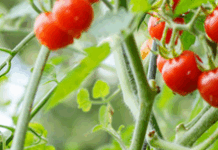It is not too late to plant tomatoes in the garden! Tomatoes are the most popular vegetable
grown in Kansas gardens. They are easy to grow, productive in small garden areas, and used in a wide variety of ways. There are about 4,000 varieties of tomatoes to choose from, so you can pick your favorite by experimenting with any you want! Big to small, green to purple, even black varieties. So have fun!
Tomatoes require a location that is fairly fertile, well-drained, and sunny, getting at least a half day of sun or more. Smaller vine tomatoes can be grown in containers.
Varieties.
Most modern tomato varieties are hybrids with disease resistance. Certain varieties produce well in our variable climate. Fl91, Jet Star, Mt. Spring, Mt. Fresh, Celebrity, Scarlet Red, Red Defender, Security28, Fabulous, and Fl 47 are adapted varieties as well as several other hybrids. Whopper and Beefmaster are large “beefsteak” types. For canning, choose the productive and firm-fruited
LaRoma, Campbells, or Heinz varieties. Small fruited or cherry varieties include Mt. Belle,
Red Cherry, Small Fry, Sweet 100, and Cherry Grande. Patio, Pixie, and Tiny Tim are dwarf
varieties well suited to container growing.
When to plant.
Plant tomatoes after all danger of frost is past. Early May is the common spring planting time. For
a later harvest, tomatoes can be planted as late as June.
Spacing.
Most garden tomatoes should be spaced at least 18 inches to 2 feet apart in rows 3–5 feet apart. Dwarf varieties can be spaced closer.
Care.
Tomatoes are usually grown from transplants. Choose a strong healthy transplant that has a dark green color and balance between the size of the plant and the container. Set the plant slightly deeper than the container and firm soil well around the root system. Water with a starter solution immediately after planting. Tomatoes respond to mulching because they require stable soil moisture. Black plastic mulch encourages early growth, while organic mulches are excellent for summer when applied 2–3 weeks after planting. Weeds compete with tomatoes for nutrients,
water, and light.
Use shallow cultivation near the plants to scrape away small weeds. A sidedressing of fertilizer when the first fruit on the plant are about the size of a walnut usually will improve yields and lengthen the harvest period. Cold nights early in the growth period or hot, dry, windy weather may cause blossom damage or blossom drop. Irregular shaped fruit called “catfaced” fruit may develop from early cold periods. Avoid excessive fertilization as it may increase catfacing and blossom drop
as well as fruit deformities.
Harvesting.
Tomatoes will ripen on or off the plant when the fruit are full sized and starting to show a slight tinge of color. Harvest early to reduce the chances of cracking, fruit rots, and other damage. Early harvest encourages additional production. Store ripening fruit at 55°F for maximum storage life or place them in a warmer location for quicker ripening. Red pigments do not form in temperatures of 95°F or above; therefore, deeper red color will result from ripening off the vine in summer heat.
At the end of the season, harvest all full-sized fruit and store them in a cool basement for ripening to enjoy fresh tomatoes 1–2 months after the last freeze.
Common concerns
- leaf blight diseases
- mites
- aphids
- blossom end rot
- fruit worms or hornworms
Debbie Church
Office Professional
Harvey County Extension
800 N Main, Room 11, P.O. Box 583
Newton, KS. 67114 316-284-6930




